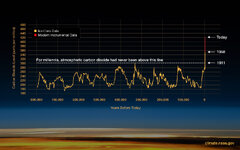Wildfires forced evacuations
across Canada. Greenland was so warm that a research station
at the ice sheet summit recorded melting in late June, only its fifth melting event on record.
Sea surface temperatures in the Barents, Kara, Laptev and Beaufort seas were 9 to 12 degrees Fahrenheit (5 to 7 degrees Celsius) above normal in August.
While reliable instrument measurements go back only to around 1900, it’s almost certain this was the Arctic’s hottest summer in centuries.
The year started out unusually wet, and snow accumulation during the winter of 2022-23 was above average across much the Arctic. But by May, high spring temperatures had left the
North American snowpack at a record low, exposing ground that quickly warmed and dried, fueling lightning-sparked fires across Canada.
In the
2023 Arctic Report Card, released Dec. 12, we brought together 82 Arctic scientists from around the world to assess the Arctic’s vital signs, the changes underway and their effects on lives across the region and around the world.
The Arctic’s declining sea ice has been a big contributor to the
tremendous increase in average fall temperatures across the region. Dark open water absorbs the sun’s rays during the summer and, in the autumn, acts as a heating pad, releasing heat back into the atmosphere. Even thin sea ice can greatly limit this heat transfer and allow dramatic cooling of air just above the surface, but the past 17 years have seen the
lowest sea ice extents on record.
SUBSEA PERMAFROST: A WILD CARD FOR CLIMATE
The report includes
12 essays exploring the effects of climate and ecosystem changes across the Arctic and how communities are adapting. One is a wake-up call about the risks in subsea permafrost, a potentially dangerous case of “out of sight, out of mind.”
Subsea permafrost is frozen soil in the ocean floor that is rich in organic matter. It has been gradually thawing since it was submerged after Northern Hemisphere ice sheets retreated thousands of years ago. Today, warmer ocean temperatures are
likely accelerating the thawing of this hidden permafrost.

